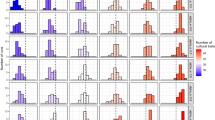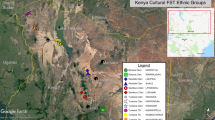Abstract
Arising from M. Derex, M.-P. Beugin, B. Godelle & M. Raymond Nature 503, 389–391 (2013)
A decade ago, Henrich1 proposed group size as a driver of cultural complexity. Derex et al.2 now present experimental results they say support this ‘group size hypothesis’ by seemingly showing that larger groups perform better than smaller groups under imitation-based cultural evolution. Our reanalysis of their experimental data, however, shows that larger groups actually perform worse than smaller groups. Thus, contrary to their claim, their data are consistent with empirical evidence discounting the group size hypothesis for non-food producing societies3,4,5,6,7,8,9,10. There is a Reply to this Brief Communication Arising by Derex, M. et al. Nature 511, http://dx.doi.org/10.1038/nature13412 (2014).
This is a preview of subscription content, access via your institution
Access options
Subscribe to this journal
Receive 51 print issues and online access
$199.00 per year
only $3.90 per issue
Buy this article
- Purchase on Springer Link
- Instant access to full article PDF
Prices may be subject to local taxes which are calculated during checkout

Similar content being viewed by others
References
Henrich, J. Demography and cultural evolution: how adaptive cultural processes can produce maladaptive losses: the Tasmanian case. Am. Antiq. 69, 197–214 (2004)
Derex, M., Beugin, M.-P., Godelle, B. & Raymond M Experimental evidence for the influence of group size on cultural complexity. Nature 503, 389–391 (2014)
Collard, M., Kemery, M. & Banks, S. Causes of toolkit variation among hunter-gatherers: a test of four competing hypotheses. Can. J. Archaeol. 29, 1–19 (2005)
Collard, M., Briggs, B., Ruttle, A. & O’Brien, M. J. Niche construction and the toolkit of hunter-gatherers and food producers. Biol. Theory 6, 251–259 (2011)
Collard, M., Buchanan, B., O’Brien, M. J. & Scholnick, J. Risk, mobility or population size? Drivers of technological richness among contact-period western North American hunter-gatherers. Phil. Trans. R. Soc. B 368, 20120412 (2013)
Collard, M., Buchanan, B. & O’Brien, M. J. Population size as an explanation for patterns in the Paleolithic archaeological record: more caution is needed. Curr. Anthropol. 54 (S8). S388–S396 (2013)
Read, D. Tasmanian knowledge and skill: maladaptive imitation or adequate technology? Am. Antiq. 71, 164–184 (2006)
Read, D. An interaction model for resource implement complexity based on risk and number of annual moves. Am. Antiq. 73, 599–625 (2008)
Read, D. The misuse of a mathematical model: the Tasmanian case (Reply to Henrich’s response). eScholarship Univ. California http://escholarship.org/uc/item/88k8g4rj (2009)
Read, D. Population size does not predict artifact complexity: analysis of data from Tasmania, Arctic hunter-gatherers, and Oceania. eScholarship Univ. California http://www.escholarship.org/uc/item/61n4303q (2012)
Author information
Authors and Affiliations
Contributions
D.R. and C.A. contributed equally to this Brief Communications Arising.
Corresponding author
Ethics declarations
Competing interests
Competing Financial Interests Declared none.
PowerPoint slides
Rights and permissions
About this article
Cite this article
Andersson, C., Read, D. Group size and cultural complexity. Nature 511, E1 (2014). https://doi.org/10.1038/nature13411
Received:
Accepted:
Published:
Issue Date:
DOI: https://doi.org/10.1038/nature13411
This article is cited by
-
“Off-Spotter”: very fast and exhaustive enumeration of genomic lookalikes for designing CRISPR/Cas guide RNAs
Biology Direct (2015)
-
Derex et al. reply
Nature (2014)
Comments
By submitting a comment you agree to abide by our Terms and Community Guidelines. If you find something abusive or that does not comply with our terms or guidelines please flag it as inappropriate.



